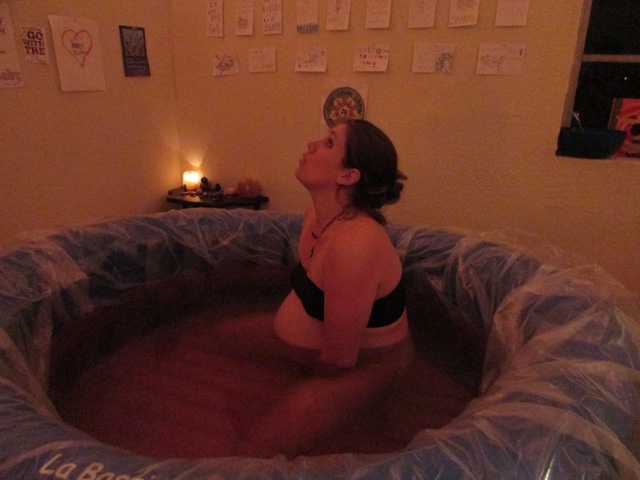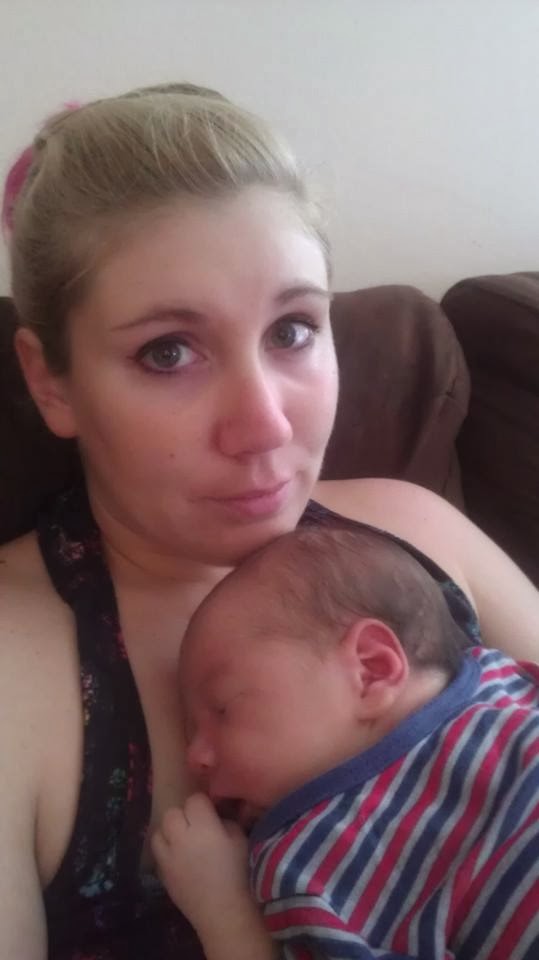Home-made At-breast Supplemental Feeding Devices
Syringe and feeding tube
A small syringe is filled with milk (collected colostrum, donor milk, formula), the tube is placed in baby's mouth while latched to the breast, and mother or support person slowly depresses the syringe to inject the milk into baby's mouth.
Pros: Good for small feedings in the early days when baby's intake is very small, perfect for feeding colostrum harvested during pregnancy (I'll be working on a post about that someday, too!)
Cons: Often requires a support person while mother is supporting baby, can be frustrating to attempt without support person, not convenient for larger feedings which would require refilling or switching out syringes
To clean: fill syringe with hot, soapy water and attach feeding tube. Force water through. Repeat with vinegar (optional) and clear water.
Recommended? It's worth a shot, at least for the first few days. But it's not easy to juggle a newborn learning to nurse AND slowly depress a syringe at the same time, so ask someone to help you! And if there's no one to give a hand, I'd recommend nursing first and then supplementing with the syringe without the feeding tube.
Feeding tube and bottle
For this version, I drilled a hole in the lid of a milk collection bottle and fed the tube through the hole. Our IBCLC gave us the feeding tubes, but you may be able to get some through a medical supply store or online.
The end of the feeding tube that attaches to the syringe goes into the bottle and helps weigh it down.
A different version of the same kind of set up, the feeding tube is fed through the nipple of a bottle making it more spill-proof.
Some moms prefer a longer feeding tube so the bottle can be placed on the table, and some moms keep the bottle close to baby.
To clean: fill a syringe with hot soapy water, and flush through the tube. You can repeat with vinegar, if you'd like. Then flush with water.
Pros: Inexpensive. Stiff tubing can be easier to insert into baby's mouth. Can be used with any size bottle or container.
Cons: Some babies dislike the feeling of the stiff tubing in their mouths.
Recommended? Yes! This is a great short-term OR long-term supplemental feeding set-up (although the tubes will need to be replaced if using long-term.)
I'd also recommend this for someone attempting to relactate or get baby back to breast before investing in the more expensive commercial at-breast supplementers.
Commercial At-breast Supplemental Feeding Devices
Medela Starter SNS
This is probably my least favorite as a low supply mom, but it could be more helpful for a full-supply mom who just needs a little help getting her supply up.
The starter SNS consists of a teat with a tube, and a valve assembly, which attaches to a 2.5 ounce collection bottle.
The Medela Starter SNS is (supposed to be) a short-term supplemental device. It's a gravity-fed system, and the height of the device dictates the flow. You can also prime the teat to "prime the pump"/release some pressure.
To clean, you take the assembly apart and rinse, then fill with hot, soapy water and reassemble, then force water through by squeezing the teat. Repeat with vinegar (optional) and clean water.
Pros: Relatively inexpensive. Okay for short-term use.
Cons: Feedings often take a long time which may tire baby out. Not really built to last. Hard to use discreetly in public (if you're into that kind of thing).
Recommended? Eh, if you get one for free, give it a shot. Not my favorite, but some people prefer it. Different strokes for different folks.
Medela Long-term SNS
I have a LOT of experience with this one, obviously. And my most recent experience taught me even more.
The Medela long-term SNS has two tubes. It's a gravity-fed device like the starter SNS, and height dictates flow. Second tube can be released to let out pressure or left open for faster flow.
The best instructions I've found for using it are on this website. http://watanabe.fastmail.jp/sns.html
To clean: rinse bottle, fill with hot, soapy water. Reassemble and force soapy water through the tubes. Repeat with vinegar and water.
Pros: 3 different tube sizes (small, medium, large). Made for long-term use, reusable bottle. Easy to see how much baby has eaten with clearly marked milliliters and ounces. Gravity-fed milk flow can be helpful for weak babies.
Cons: Prone to leaking if cap is too loose or too tight. Expensive to replace tubes or missing parts. Hard to use discreetly in public.
Recommended? Sure. I used it for years, although I always said I had a love/hate relationship with my SNS.
Lact-aid Nursing Trainer
Somehow that blue thing is supposed to help you hold up the bags while filling, but I just stick the bag in a clean coffee cup. The funnel goes into the bag for filling. The little white thing is a filter for formula, you insert into the funnel. Then there's an assembled lact-aid, and cleaning syringe.
The lact-aid is hard to describe. And I know it looks overwhelming. I was overwhelmed, myself.
The lact-aid is not a gravity-fed device, and in the early days, my baby was not strong enough to remove milk well. The bags also have no units of measurement printed on them, so unless baby has been able to remove an obvious amount of milk, it can be hard to tell if the milk is flowing at all.
Once my little guy was gaining well and gaining strength, we got the hang of the lact-aid and never looked back. Now that it works for us, it is THE BEST THING EVER!
Cleaning is pretty easy with the bulb syringe. Fill it with hot, soapy water, flush the lines. Repeat with vinegar. Repeat with water. No sweat.
Pros: Looks complicated, but isn't. Easy to tuck in bra and go. More discreet use in public. Less leaks than Medela SNS. Multiple units make life easier.
Cons: Not cheap. May be difficult for a struggling baby, can be hard to tell if the milk is flowing, bags are single use*, bags aren't marked in mililiters or ounces so harder to monitor baby's intake.
Recommended? Yes. This one is by far my favorite. Unlike the Medela SNS, I have a love/love relationship with this one. If you do get the lact-aid and fall in love with it, get as many units as you can. Makes life much easier. :)
*I've heard some people wash and re-use bags, but for liability's sake, you didn't hear it from me.

























































